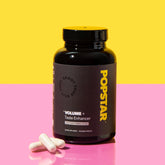

As doctors, we talk a lot about the impact of a vasectomy on sexual health and satisfaction. However, many men don’t fully understand what semen is before and after a vasectomy and precisely what to expect for sex after having one. Therefore, we wanted to take some time and explain the basics of semen physiology and answer the most common questions we received.
What Makes Up My Load?
Men make around 3ml of semen with each ejaculation, just less than a teaspoon.
Most of the semen volume is not living sperm. In fact, most of the fluid in semen is made of secretions from the male reproductive organs along the way. Only 10% of the total ejaculation is sperm. Don’t get us wrong, that’s still 100-200 million swimmers making the journey! However, that means 90% of your load is made of other things. The reason is that the living sperm need a lot of nutritional support for the journey and some enzymes to accomplish tasks along the way. About 50-75% of the volume will be made of fluid produced by the seminal vesicles, small pockets that hold sperm before they leave the body during an orgasm. The prostate makes up to 15-30% of the volume, with about 2-5% coming from accessory glands in the testicles and urethra.
How is Sperm Made & How Does It Leave the Body?
Within the adult testicle, there is almost 600 feet of tubing. At the very beginning of these tubes, sperm production begins. Small stem cells mature into living sperm within the testicle. The entire process of sperm production from start to end will take around 60 days, and almost 120 million sperm are made by a man in a day! That’s about 1000 sperm produced every second, and the process continues your entire adult life, slowing a little in the end. Once the sperm are made and mature, they leave the testicle and enter a small structure right next door called the epididymis. This small organ, right next to the testicle, is where sperm finish maturing and get ready for their journey. During ejaculation, sperm are propelled out of the epididymis through a long tube called the vas deferens and out of the body. Along the way, the sperm pick up all the nutrients they need to survive the journey and some enzymes needed to fertilize an egg. The majority comes from the seminal vesicle, comprised of fructose for semen energy, prostaglandins to protect the sperm in the vagina, alkaline fluid to balance the acidic nature of the vagina, and some clotting factors to prolong the life of the sperm. Without these, the sperm could not survive the journey or impregnate an egg.
What Exactly is a Vasectomy?
A vasectomy is a procedure that disconnects the testicle from the seminal vesicle and the prostate. The small tubes that leave the testicle and epididymis are called the vas deferens. A man will have two tubes, one on the right and one on the left. This tube is about 12 inches long and about the size of a piece of cooked spaghetti. A vasectomy involves making a small opening and disconnecting the vas tubing. The procedure typically takes 10 minutes and can be done in several ways. For example, the tube can be divided with a scalpel, clipped with staples, tied off with suture, or even burnt with special cautery. Regardless, having a vasectomy prevents living sperm from making its way out of the body.
What Happens to My Orgasms and Loads After a Vasectomy?
Following a vasectomy, most men are advised to avoid having sex for about 5-7 days to allow for adequate healing. In addition, men are advised to continue using protection for several weeks to let all the old sperm in the tubing get out of the body. It takes about 25 ejaculations to be completely sterile and safe to have unprotected sex. The testicles do continue to make sperm, but because there is no connection to the penis, the sperm cannot get outside and will naturally get reabsorbed by the testicle.
After the healing process, men can resume sexual activity without concern. Most men will have no impact on the feeling of orgasm. Sexual excitement, erections, and orgasms are not affected by a vasectomy. In addition, since only 10% of the semen load volume was sperm, most men will say the volume of their ejaculate is slightly less.
Can I Take Popstar After a Vasectomy?
We developed Popstar men's health supplement to improve semen health, volume, and taste. For men who have had a vasectomy, Popstar does not have any impact on the procedure. This means Popstar will not put you at risk of pregnancy or change your fertility status. If you have had a vasectomy, you will be at no increased risk of getting your partner pregnant if you take Popstar. However, for men who notice a decrease in load volume after vasectomy, Popstar can help. Popstar is designed to work on the accessory glands and organs, thus promoting the 90% of load volume that is nutrients and enzymes. Popstar helps these organs produce more volume.








